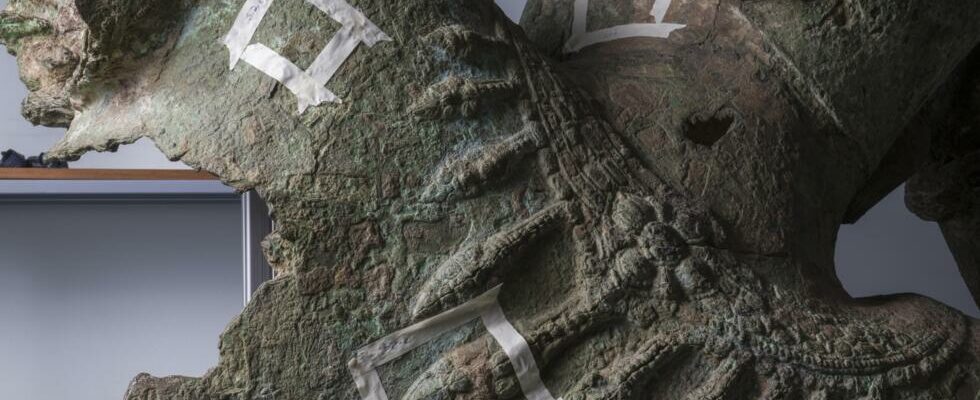The Vishnou of Western mebon, one of the greatest bronzes ever found in Angkor in 1936, is part of the collections of the National Museum of Cambodia. This statue of the 11th century, of more than 5 m at the origin, represents the Hindu Vishnou god, lying on the ocean of eternity. Arrival in France in May 2024 for technical studies and in November in Nantes at the Arc’antique laboratory for its catering, this unique piece will then be presented at the Guimet Museum in Paris, from April 30 to September 8.
It is placed on a cart in a room in the Arc’antique laboratory, in Nantes, in the west of the France. The great Vishnu imposes it by its sweetness. It looks like a hospital bed. Only the upper part of the statue is exposed, including the head, the two right arms and the top of the chest. All the same exceeding 2.20 m long. At his bedside, Stéphane Lemoine seems very small, as this bronze is monumental. This metal specialist participates in catering. You must first clean. White adhesive tape delimits the small square areas on which must be intervened.
“” We already see that there is a state of enclosure located on corroded surfaces, which therefore retain burial sediment and which harm the overall readability of the models of the work. You can choose to remove these stakes more or less, in particular by mechanical means, in an attempt to find the surface which was the object at the time of its abandonment, in the middle of the 15th century. You have to imagine that at the time, the entire surface of the Vishnu was golden. Today, it is green, because the fine gilding – which was an applied gilding with mercury – disappeared very quickly during burial. There are plots left, but you have to imagine that this statue, now green, was at the time fully golden “Explains the restaurateur.
Completely gilded, the Vishnou flamboyed. But that was not all, there was polychromy on the eyebrows, eyes, mustache, lips were red. Treasures of the National Museum of Cambodia In Phnom Penh, an unequaled masterpiece of Khmer art, this lying Vishnu dating from the 11th century captive Yannick Lintz, president of the Guimet Museum, in Pariswho made the trip.
“” Vishnou, as a personality, was obviously one of the great deities of the religious pantheon of Cambodia and all of Southeast Asia, that is to say spiritually and religiously a deity of very great importance. And then, as is the case in our history of art, the great religious works are also great art. This great monumental bronze of this lying Vishnu who lived in the middle of the temple that is called the temple of mebon, in Angkor, it is as symbolic as the Mona Lisa of the Louvre She enthuses.
We regret this smiling Vishnou and the serenity that he gives off. But we can find it during a exposure Exceptional on Khmer bronzes, which will be held at the Guimet Museum next April.
Read tooThe Metropolitan Museum of Art in New York returns 14 Khmerian sculptures in Cambodia
